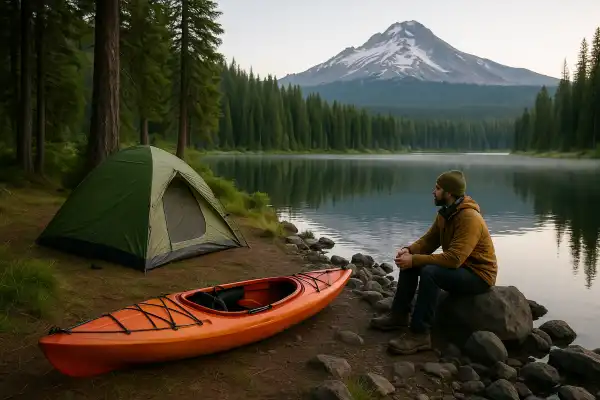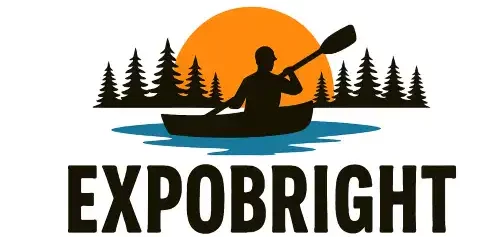Where can you kayak camp in Oregon is a question that draws paddlers from across the country to this Pacific Northwest paradise. Oregon’s unique geography creates an exceptional variety of waterways, from pristine alpine lakes nestled in the Cascade Mountains to Wild and Scenic rivers cutting through ancient forests.
Having guided countless paddlers through Oregon’s waterways over the years, I’ve witnessed firsthand how the state’s diverse landscapes offer everything from secluded backcountry experiences to family-friendly adventures. The challenge lies not in finding places to kayak camp, but in choosing which of Oregon’s remarkable destinations to explore first.
Must read for your safety when kayak camping: How to get rid of spider in a kayak?
Where can you kayak camp in Oregon?
Oregon offers dozens of exceptional kayak camping destinations spanning mountain lakes, designated Wild and Scenic rivers, coastal areas, and high desert waterways. Waldo Lake stands at the top of most Oregon paddler’s lists for late-summertime adventures, featuring 200 nicely developed campsites along its eastern shore and representing just one of many premier paddling destinations across the state.

Central Oregon’s alpine lakes
The Cascade Lakes Highway corridor provides access to some of Oregon’s most spectacular kayak camping destinations. Waldo Lake, with its record-setting water visibility measured over 150 feet, offers direct access to the lake’s shallower shoreline from North Waldo campground. This 9.8-square-mile lake sits at 5,400 feet elevation and benefits from a 2010 gas motor ban that preserves its pristine environment.
Sparks Lake features 20+ secluded paddle-in campsites along its shoreline, creating a backcountry camping experience with car camping convenience. Situated at the base of Mount Bachelor with stunning views of South Sister and Broken Top, this shallow lake reaches only 10 feet in depth and sits at 5,433 feet elevation. The paddle-in sites offer privacy and spectacular mountain vistas, though access requires navigating the notoriously rough forest road.
Crane Prairie Reservoir, located 30 miles southwest of Bend, serves as one of Central Oregon’s top rainbow trout fisheries. The reservoir offers multiple camping areas with easy kayak access and excellent fishing opportunities. Nearby Elk Lake, Suttle Lake, and the Twin Lakes provide additional high-elevation camping options along the scenic Cascade Lakes Highway.
Wild and Scenic rivers
The Rogue River, designated Wild and Scenic, offers multi-day kayak camping expeditions through steep cliffs and wilderness areas. Commercial outfitters handle permits and logistics for guided trips, while private groups can apply for permits through the reservation system. The river provides established camping areas along its remote stretches, creating an authentic wilderness experience.
The Deschutes River flows through Central Oregon’s high desert, offering various access points and camping opportunities. The river’s character changes seasonally, from Class II+ conditions during spring snowmelt to gentler Class II- flows in summer. Multiple developed campgrounds along the river provide kayak access, while the surrounding Deschutes National Forest offers dispersed camping options.
The Willamette River, stretching 187 miles through northwest Oregon, provides numerous camping opportunities along its course. The river passes through diverse landscapes from mountain headwaters to urban Portland, offering everything from wilderness camping to developed facilities near cities.
Mountain lake destinations
Diamond Lake Campground offers 238 campsites along the eastern shore, with 51 sites resting directly on the lake. Nestled between Mount Thielsen and Mount Bailey in the Umpqua National Forest, this popular destination attracts 700,000 visitors annually and provides easy access to Crater Lake National Park.
Detroit Lake State Park Campground provides full amenities including amenities and excellent access to the large reservoir. The campground offers upwards of developed sites with views of Mount Jefferson, creating an ideal base for multi-day kayak camping adventures.
Lost Lake Campground near Mount Hood provides a spacious area that represents one of Oregon’s oldest privately run campgrounds. The location offers excellent mountain views and serves as a gateway to the Mount Hood region’s numerous alpine lakes.
Coastal kayak camping
Nehalem Bay State Park serves as an excellent central location on the Oregon Coast, providing access both north toward Cannon Beach and south to Cape Kiwanda. The park’s six camping loops offer protected sites behind the dunes, with easy kayak access to the bay’s calm waters.
Oregon’s coastal rivers and estuaries provide unique kayak camping opportunities where freshwater meets the Pacific. These areas offer chances to explore tidal environments while camping in protected state park facilities or designated primitive areas.
Eastern Oregon destinations
Mann Lake Recreation Site, located north of the Alvord Desert, holds water year-round and features quaint campsites with immediate lake access. This high desert destination offers excellent fishing opportunities and represents a completely different landscape from Oregon’s mountain regions.
Wallowa Lake State Park Campground provides an excellent base camp for exploring the undertrodden Wallowa Mountain Range. The campground offers over 120 campsites and access to hundreds of miles of hiking trails, creating opportunities for combined paddling and backcountry exploration.
Permits and regulations
Oregon requires a Waterway Access Permit for all non-motorized watercraft 10 feet and longer. These permits cost $7 for one week, $17 for one year, or $30 for two years, with children 13 and younger exempt from permit requirements. The permits fund the Aquatic Invasive Species Prevention Program and waterway access improvements.
All paddlers must carry US Coast Guard-approved life jackets for each person on board. Vessels operating between sunset and sunrise require white lights visible from all directions. Visual distress signals become mandatory when paddling federally controlled waters, including coastal areas and the Columbia River mouth.
Conclusion
In 2020, I spent three days kayak camping at Waldo Lake with my family, watching the sunrise paint South Sister’s peaks while sipping coffee from our lakeside camp. We paddled to different coves each day, discovering hidden beaches and crystal-clear swimming holes that felt like our private wilderness sanctuary. That trip reminded me why Oregon consistently ranks among the world’s premier paddling destinations.
Following a comprehensive guide to Oregon’s kayak camping locations transforms a good outdoor adventure into an unforgettable experience. The difference between randomly choosing a spot and selecting the perfect destination based on conditions, regulations, and seasonal timing can mean the difference between a challenging ordeal and the trip of a lifetime.
Follow Expobright for exclusive kayak and canoe camping tips.
